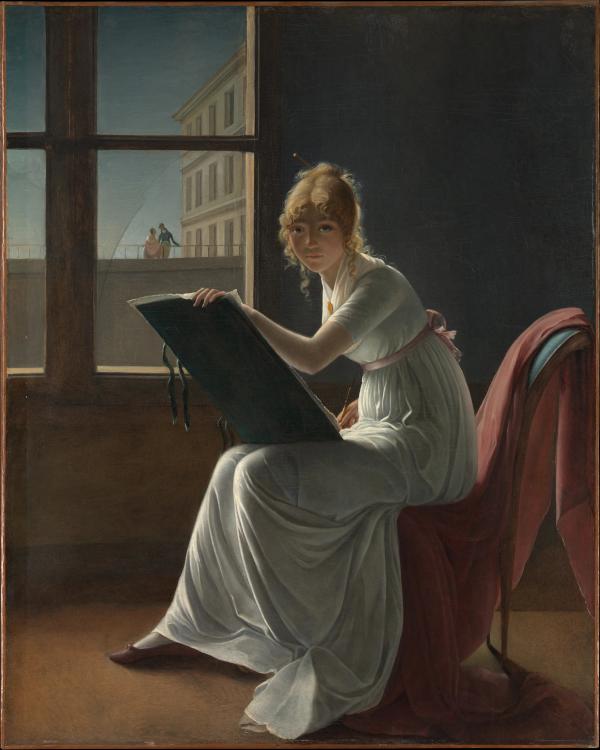Marie Joséphine Charlotte du Val d'Ognes (1786–1868)
A woman looks up from her drawing, perhaps better to study us. The simple interior may represent a studio in the Louvre. The broken windowpane framing the distant couple, an unsettling detail, demonstrates the artist’s technical skill. Villers was the sister of the painter Marie Victorine Lemoine and a pupil of Anne Louis Girodet-Trioson, Jacques Louis David’s student. Taking advantage of newly open submission procedures for women painters at the Salon, she exhibited this work publicly in 1801 under her name, but it was soon incorrectly ascribed to David—a misidentification perpetuated until the 1950s. Due in part to this history, the painting appeared on the cover of a 1971 issue of Artnews that featured a watershed call to reevaluate art history, Linda Nochlin’s "Why Have There Been No Great Women Artists?"
Artwork Details
- Title: Marie Joséphine Charlotte du Val d'Ognes (1786–1868)
- Artist: Marie Denise Villers (French, Paris 1774–1821 Paris (?))
- Date: 1801
- Medium: Oil on canvas
- Dimensions: 63 1/2 × 50 5/8 in. (161.3 × 128.6 cm)
- Classification: Paintings
- Credit Line: Mr. and Mrs. Isaac D. Fletcher Collection, Bequest of Isaac D. Fletcher, 1917
- Object Number: 17.120.204
- Curatorial Department: European Paintings
Audio

Marie Denise Villers’s Marie Josephine Charlotte du Val d'Ognes | Gallery 634
For years, this painting was hailed as a masterpiece by a famous male artist. Then, it was reattributed to a woman...Listen for the whole story.
KATY HESSEL: In 1917, for $200,000, The Met bought this portrait of a mysterious young woman artist sketching at her easel. Dappled in dramatic sunlight, she’s looking right at the audience.
KATHRYN CALLEY GALITZ: There’s this directness to her gaze, and she’s really drawing you in and acknowledging you.
HESSEL: Art historian, Kathy Galitz.
GALITZ: The painting was made in 1801… and by the time the Museum acquired this work in 1917, it was attributed to the leading male neoclassical painter of the day, Jacques-Louis David.
HESSEL: And when the work was acquired by The Met, it instantly became a popular attraction. It was promoted as “the New York David.”
GALITZ: David was very much in the air.
HESSEL: But here’s the thing—the painting wasn’t by Jacques-Louis David.
GALITZ: In 1996, a woman art historian named Margaret Oppenheimer identified the author of this painting. And her name is Marie Denise Villers.
HESSEL: This incredible painting was crafted by a female artist who studied with David’s contemporaries. This kind of misattribution isn’t uncommon.
GALITZ: Other museums across the United States have ex-Davids that it turns out, by and large, many of them had been painted by a woman.
And at the time, that is in the late eighteenth and early nineteenth century, these women artists were known and recognized. And this to me, this blew my mind to read this, women had more prominence in Europe in that period than they do in European and American museums today.
HESSEL: In the aftermath of the French Revolution, a time of great social progress, women artists had more opportunities to exhibit their work: the annual Paris Salon opened up to all artists, including women, in 1791.
GALITZ: It was only with the passage of time that their identities became lost.
The past few decades have shown in various ways a kind of questioning of the canon of art history and not accepting the status quo. And part of it was that many women art historians didn’t accept necessarily that all of these works were by David or were by his male students. And that why couldn’t they have been painted by women who we know studied with David and who we know exhibited and were active at that time? Where are these paintings, then? They were there a hundred, two hundred years ago, so where are they now? And then making these discoveries that, in fact, they’re literally right in the midst of our museums and in our galleries if we do a little digging, and do a little looking.
And what’s also interesting and I think maybe a subtle bit of subversiveness, if you will, is that a lot of women artists painted either self-portraits of themselves at work or portraits of other artists at work. And in the case of the Museum’s painting, it is thought that this is a portrait of a young art student called Charlotte Val d’Ognes. But that these women were showing themselves as artists or other women as artists, it’s almost as if to say, “Hey, you know, we’re here, and you have to take notice.” And it’s just a statement-making work in that way.
HESSEL: Listen on to hear more incredible stories about women artists at The Met.
More Artwork
Research Resources
The Met provides unparalleled resources for research and welcomes an international community of students and scholars. The Met's Open Access API is where creators and researchers can connect to the The Met collection. Open Access data and public domain images are available for unrestricted commercial and noncommercial use without permission or fee.
To request images under copyright and other restrictions, please use this Image Request form.
Feedback
We continue to research and examine historical and cultural context for objects in The Met collection. If you have comments or questions about this object record, please contact us using the form below. The Museum looks forward to receiving your comments.
